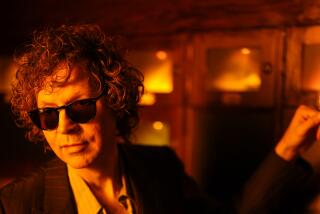PROFILE : The ‘Choice’ Is His : David Ciaffardini’s Ojai-based magazine reaches an underground of alternative music lovers.
- Share via
The humble, idyllic town of Ojai means many different things to many different folks. To contemporary classical music lovers, the annual Ojai Festival is one of the finest small festivals in the world. Mystics of varying stripes have long gathered and repaired in this valley.
And to more than 5,000 alternative music lovers around the world, Ojai is the home base of Sound Choice, a magazine started in 1984 by self-styled magazine magnate David Ciaffardini. The Sound Choice headquarters is unassuming--a utilitarian, three-room, concrete-floored space behind an auto shop, located on a side street.
“Nobody in the town actually knows what I do here,” Ciaffardini said in his office recently. “You can’t even get the magazine here in town. There’s only one place in Ventura--Wild Planet--where you can get it.”
More than anything, Ciaffardini is known here as a mild-mannered reporter who does occasional work for the Ojai Valley News. “I’ve just been here, with a kind of low-key existence,” Ciaffardini said. “They know me on a first-name basis at the post office, because I get all my mail there. The postal workers say I get more mail than anyone else.” This may or may not be grounds for a civic commendation.
Ciaffardini is happy to base Sound Choice in Ojai, even though a college town might yield more volunteer office help. As Ciaffardini commented, “In a way, one of the advantages of being apart from a media center is that there is no problem with (music industry) people coming over, putting pressure on you.”
Sound Choice is the offspring of the now somewhat legendary Op magazine. College radio programmer John Foster founded that prototypical alternative music fanzine in Washington state. In five years, he intentionally published only 26 issues--one for each letter of the alphabet (John Zorn, for instance, was the lead subject in the final issue). The idea, according to Ciaffardini, was to create “a sort of encyclopedia of lost music.”
After Op finished its cycle, Foster held an independent music conference. In effect, he offered the blueprints for his operation--tips, a valuable mailing list and distributor information--to any takers. Ciaffardini, then a fledgling journalist looking for a worthy cause, was one of the attendees. “I was young, naive, fresh out of college,” he said.
Originally, Ciaffardini sent out an introduction to his proposed new magazine to a list of 1,000 subscribers and got a 50% response rate. What Ciaffardini didn’t anticipate was the amount of sheer legwork involved in putting out a magazine--even a quarterly. “Nine out of 10 man hours are spent on the logistics--mailing out your bills, making sure subscribers are taken care of.”
The large task of putting out a magazine, especially a specialist one with a small profit margin, must necessarily be a labor of love--and sometimes a matter of braving its opposite.
“I interviewed John Foster in our first issue,” Ciaffardini remembered. “I asked him ‘What did you accomplish in your five years of doing this?’ He said: ‘Getting a lot of people to hate me.’ He washed his hands of the whole thing.”
Timing worked in Ciaffardini’s favor. As the music industry fragmented into multiple directions in the mid-80s, a kind of independent music boom occurred, with college radio leading the charge. Before long, the major record labels caught wind of a new, lucrative demographic group and jumped on the bandwagon.
Still, as the do-it-yourself impulse spread and home recording became more and more affordable, a vast independent music network evolved. It was this “underground” world which Sound Choice addresses.
Ciaffardini takes the visiting reporter to his vault, where he roughly categorizes the bounty of cassettes and CDs he gets--in the mail, of course--for review in the magazine. Large plastic bins are marked by genre: folk, classical, rock, jazz, avant garde and the proverbial “other.” How is “other” defined? “It could be anything,” he said. “We’ve been getting a lot of children’s music now.”
Music, per se, isn’t the magazine’s only point of interest. The Winter ’91 issue of Sound Choice features an extensive interview with Timothy Leary, as well as a section on “music consciousness.”
“We usually don’t put people on the cover. In a way, I was against that. I wanted to be different, and that was a way of promoting rock stars. I also realize now that the magazines that sell are the ones with a face.”
UP CLOSE DAVID CIAFFARDINI
Who: 32-year-old publisher/owner.
Of what: Sound Choice, an alternative music magazine
Where: In Ojai.
For whom: “There is a variety of people who read Sound Choice,” Ciaffardini said. “Let’s look at the first ones I pull out here: an attorney, another attorney, a student, news reporter and broadcaster, an editor, produce man, psychotherapist, a musician-accountant. Most of our readers are in the 28 to 32 range.”
Why: “Our generation is one that didn’t really have their own music, so much. In the ‘60s, you had music that everybody listened to. In the ‘70s, you had people like me who were exposed to a lot of music, but there wasn’t any particular band that everybody rallied around. This generation, these people, since they don’t have one specific music, are looking. They’re into lots of different kinds of music.”
More to Read
The biggest entertainment stories
Get our big stories about Hollywood, film, television, music, arts, culture and more right in your inbox as soon as they publish.
You may occasionally receive promotional content from the Los Angeles Times.










